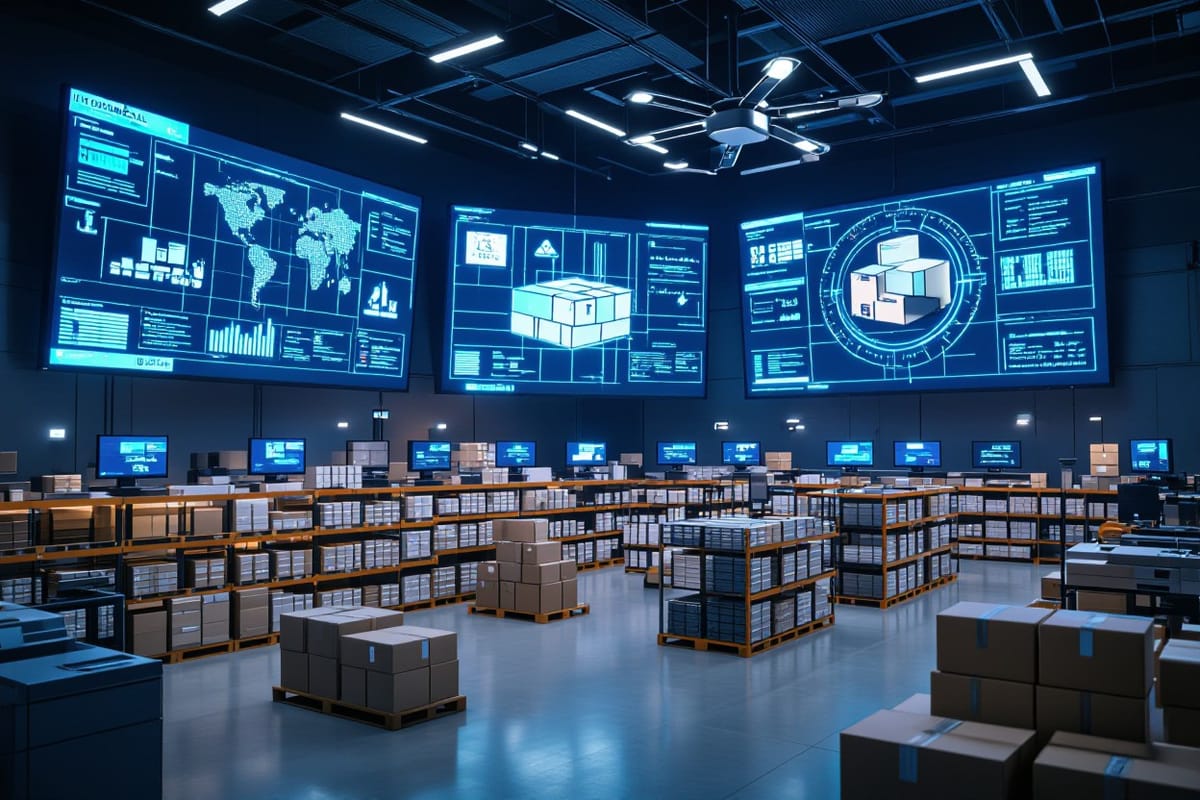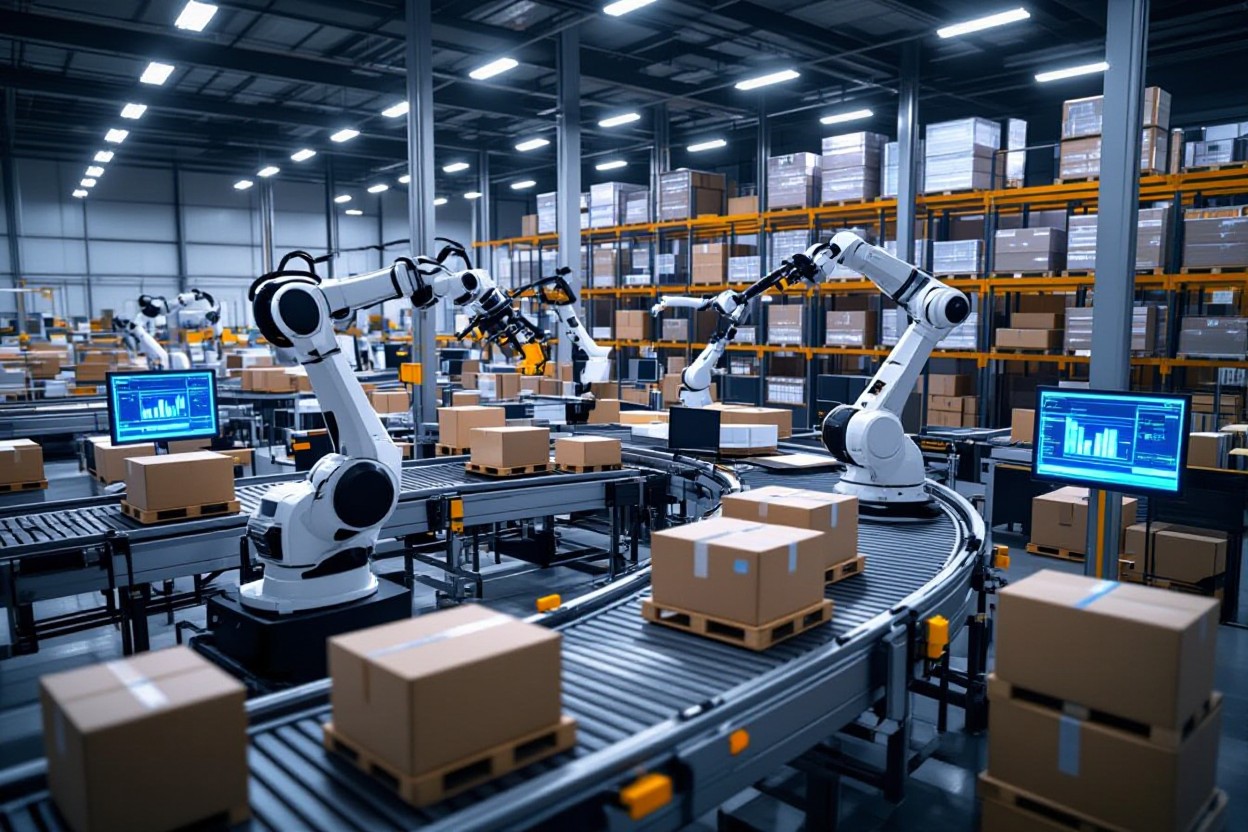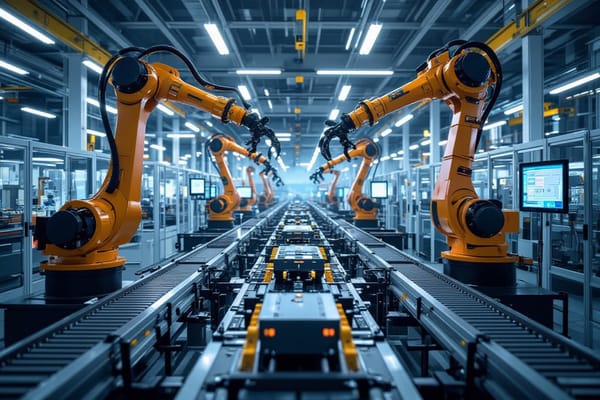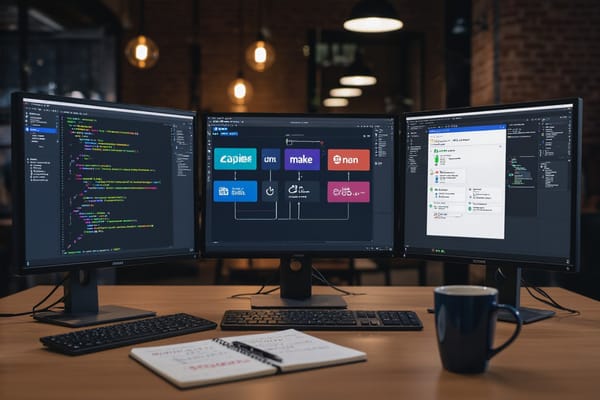The Intelligent Supply Chain: AI Automation for Unrivaled Efficiency

Efficiency defines how you convert data into reliable, real-time supply chain decisions by applying AI automation across forecasting, inventory optimization, route planning, and exception management. You gain predictive visibility, faster fulfillment, and reduced waste while automated workflows scale operations and free your team to focus on strategy. This guide explains practical AI tools, implementation steps, and performance metrics to help you realize measurable efficiency gains.
Key Takeaways:
- AI delivers end-to-end visibility and predictive analytics to anticipate demand, optimize inventory, and reduce stockouts and overstock.
- Automation orchestrates warehousing, transportation, and procurement to accelerate workflows, cut operational costs, and improve delivery reliability.
- Continuous data integration and human–AI collaboration enable faster decision-making, scalable resilience, and governance for responsible deployment.
Understanding Supply Chain Management
You manage flows of materials, information and cash across suppliers, manufacturers, distributors and retailers; key KPIs include on-time delivery, inventory turnover (days), fill rate and working capital. Expect trade-offs between inventory carrying costs and service levels; multi-echelon optimization can cut inventory by 10–30% in large networks. Lead times, supplier reliability and demand variability determine safety stock and planning horizon, so you measure lead-time variability and supplier OTIF closely.
The Traditional Supply Chain Model
You operate a largely linear flow: suppliers → manufacturer → distributor → retailer. Reliance on forecasts and batch production creates the bullwhip effect; small demand swings often translate into up to 25–40% amplified order variability upstream in some industries. Toyota's just-in-time system reduced WIP and lead times, yet JIT raises vulnerability to disruptions. Legacy silos between procurement, production and logistics slow response times and inflate buffer inventories.
The Role of Technology in Supply Chain
You can layer ERP, TMS, WMS, IoT sensors, RFID and AI forecasting to collapse lead times and lower error rates. McKinsey finds digital forecasting can cut forecast errors by 20–50% and inventory by 20–30% in some pilots. Blockchain pilots like TradeLens aim to improve visibility across carriers and customs. Machine learning identifies demand signals from POS, weather and socioeconomic data to refine replenishment rules.
You see concrete ROI: Amazon's 2012 $775M acquisition of Kiva Systems accelerated robotics adoption, enabling dynamic slotting and faster picks across fulfillment centers. Maersk and IBM launched TradeLens in 2018 to digitize bill-of-lading flows, reducing paperwork delays between carriers and ports. Pilot programs using IoT cold-chain sensors cut spoilage and enable automated hold/release decisions; predictive maintenance pilots deliver double-digit reductions in unplanned downtime, shifting CAPEX and staffing needs.
The Rise of Artificial Intelligence in Supply Chains
You’re seeing AI move from pilots into core operations: McKinsey estimates $1.2–2.0 trillion of value across supply chains and manufacturing, and companies like Amazon and Walmart deploy ML-driven replenishment to cut forecast error by 20–50% and sharply reduce stockouts. Real-time control towers now ingest sensor, ERP and carrier data to reroute shipments, prioritize SKUs and coordinate multi-echelon inventory for millions of items, shrinking lead times and improving on-time delivery at scale.
Key AI Technologies Impacting Supply Chains
Machine learning sharpens demand forecasting and price optimization; computer vision automates quality checks and inventory counts at high throughput; NLP accelerates procurement by parsing contracts and supplier messages; robotics and autonomous vehicles speed fulfillment and last-mile delivery; digital twins let you run thousands of disruption scenarios; reinforcement learning optimizes dynamic routing and storage allocation in live environments.
Benefits of AI Automation
You capture lower costs, higher service levels and faster decision cycles: AI can cut transportation and labor spend (often 5–15%), reduce forecast error 20–50%, and help firms like UPS save millions of gallons of fuel via route optimization. Improved demand visibility raises fill rates, lowers safety stock, and reduces markdowns while enabling near-real-time exception management.
Digging deeper, AI-driven control towers and planning systems improve KPIs you track daily: inventory turns rise, cash-to-cash cycles shorten, OTIF rates climb, and lead-time variability drops. You can simulate supplier failures, reprice SKUs, and reallocate inventory across regions in minutes instead of days, converting predictive insights into automated execution that protects margins during volatility.
Enhancing Efficiency Through AI
You accelerate throughput and cut waste by applying AI across planning, warehousing, and transport: route optimization reduces transit miles, computer vision speeds picking accuracy, and predictive maintenance limits downtime. Pilot programs report 20–35% faster order fulfillment and 15–25% lower logistics costs, so your teams can reallocate labor to higher-value tasks while you shrink lead times and improve on-time delivery.
Predictive Analytics and Demand Forecasting
You combine POS data, market signals (weather, promotions, social trends), and IoT telemetry with hybrid models like LSTM and gradient-boosted trees to lift forecast accuracy by 10–30%. Better forecasts let you tune replenishment cadence, reduce stockouts, and capture incremental revenue—case studies show lost-sales reductions around 2–5% after deploying advanced demand-sensing pipelines.
Inventory Management and Optimization
You shift from static safety stock to SKU-level, demand-driven policies and multi-echelon inventory optimization, which often trims inventory by 15–30% while preserving target service levels (commonly 95%). Dynamic reorder points, depletion-based replenishment, and automated cycle counting let your working capital fall as fill rates stay high.
You calculate safety stock from demand and lead-time variability using service-level z-scores (for example, z≈1.65 for 95%), then integrate lot-sizing, periodic vs continuous review, and supplier lead-time reduction into the model. You should run scenario analyses—varying lead time by ±20% or demand variance by ±30%—to see inventory and service-level impacts, and apply multi-echelon optimization to balance stock across DCs and stores for lowest total cost.
Case Studies: Successful AI Implementation
You see measurable outcomes when AI is applied end-to-end: Amazon cut warehouse picking time by ~20% and increased throughput 25%, Maersk improved ETA accuracy 15% and cut demurrage 12%, and DHL trimmed last‑mile costs 10% with dynamic routing; more examples and event-driven trends are discussed at Integrating Automation and AI | NC State MEM.
- 1) Amazon Robotics — 20% reduction in pick time, 25% increase in lines-per-hour after integrating vision-guided robots with ML task allocation (pilot to scale in 18 months).
- 2) Maersk Predictive ETAs — 15% better ETA accuracy and 12% drop in demurrage fees using global AIS + weather models across 4 major trade lanes.
- 3) DHL SmartRouting — 10% last-mile cost savings and 8% uplift in on-time delivery by combining historical telematics with real-time traffic feeds across 200 hubs.
- 4) Walmart Demand Forecasting — 30% improvement in forecast accuracy and 35% fewer stockouts for seasonal SKUs after deploying hierarchical ML models across 3,500 stores.
- 5) Siemens Predictive Maintenance — 40% reduction in unplanned downtime and 12% OEE gain via sensor-driven anomaly detection across 50 factories.
- 6) Maersk/ByLogistics Hybrid Example — 18% reduction in inventory carrying costs and 22% shorter lead times after synchronizing supplier forecasts with dynamic safety stock algorithms.
Industry Leaders Utilizing AI
You can look to market leaders who tie AI to operations: Amazon automates picking and sorting, DHL applies routing AI across city networks, Maersk leverages predictive ETAs for ports, Walmart runs ML-driven replenishment across thousands of SKUs, and Siemens uses predictive maintenance to slash downtime—these examples show both breadth of use and measurable KPIs you can benchmark against.
Lessons Learned from AI Adoption
You should invest in data readiness and clear ROI metrics: teams spending 6–12 months on data cleansing saw model accuracy rise ~25%, pilots with defined KPIs reached positive ROI in 12–18 months, and allocating ~15–25% of the project budget to change management drove adoption rates above 80%.
Operationalizing models requires MLOps and governance—automating retraining cut performance drift by ~30% in mature programs, central feature stores reduced reproducibility issues by 40%, and projects lacking executive sponsorship had a ~30% higher chance of stalling; align KPIs, set SLOs for model performance, and plan for continuous monitoring to sustain benefits.

Challenges and Considerations
You encounter trade-offs across data quality, integration, and change management: pilots may cut forecasting error by 20% but falter when scaling to 50+ warehouses without standardized APIs and master data; security, regulatory reporting, and CFO ROI windows of 6–12 months add pressure. For architecture and integration patterns see Combining AI, Automation, and Real-Time Data - Blog.
Potential Pitfalls of AI in Supply Chain
You can see model drift degrade accuracy over months, turning expected 10% forecast improvements into losses; biased training data may cause double-digit overstocking on seasonal SKUs, while siloed systems create reconciliation delays measured in days rather than hours and amplify supplier disputes.
Overcoming Barriers to Implementation
You should run focused pilots (3–6 months) on 1–5 high-impact SKUs, set KPIs like a 5–15% fill-rate lift and 10–20% lead-time cut, form a cross-functional governance team with weekly sprints, and standardize APIs and master data before scaling.
You mitigate adoption risk by upskilling 15–30% of operations staff with role-based training, automating 60–80% of low-value manual tasks in phase one, and using A/B regional rollouts to validate KPIs; enforce model governance with daily monitoring, weekly drift checks, monthly retraining, and require vendor SLAs plus a 6–12 month ROI forecast before enterprise rollout.

The Future of AI in Supply Chains
AI will move your supply chain from reactive to predictive: advanced forecasting, dynamic routing, and automated sourcing will cut lead times and inventory costs while improving service levels. Practical playbooks at Intelligent Automation for Supply Chain show how combining sensor telemetry with prescriptive models produces 20–40% lead-time reductions in pilot implementations across multi-tier operations.
Emerging Trends and Innovations
Edge AI and digital twins let you run millions of scenarios in minutes, with pilots reporting 20–30% downtime reductions and faster recovery; generative AI speeds procurement and contract drafting, while autonomous vehicles and drones cut last-mile expenses. Blockchain improves provenance for recalls, and 5G enables low-latency telemetry—prioritize modular, API-first platforms so you can integrate these innovations without a forklift upgrade.
The Evolving Role of Human Oversight
Human roles shift toward exception management and governance: you will validate model outputs, approve high-impact actions, and set ethical and service-level boundaries. Procurement teams will audit supplier scoring, planners will review AI-driven inventory cuts, and operators will intervene on complex reroutes to maintain resilience and stakeholder trust.
Operationalize that shift by creating explicit roles—AI ops, data stewards, and model auditors—and embedding SLAs and thresholds into workflows (for example, route decisions flagged when model confidence <60% or require human sign-off for orders over a set dollar value). Implement continuous monitoring dashboards, automatic retraining cadences, A/B tests for new models, and immutable audit logs to prove compliance and explainability during audits and post-incident reviews.
Conclusion
From above, you can see how AI-driven automation transforms your supply chain by forecasting demand, optimizing routes, and automating repetitive tasks, enabling faster decisions and reduced waste. By integrating intelligent systems, you gain transparency, scalability, and continuous improvement that keep your operations efficient and resilient in changing markets.
FAQ
Q: What does "The Intelligent Supply Chain" mean and what tangible benefits can organizations expect from AI automation?
A: "The Intelligent Supply Chain" refers to an integrated ecosystem where AI-driven capabilities — including predictive analytics for demand forecasting, prescriptive optimization for routing and inventory, computer vision for quality inspection, and autonomous robotics for warehousing — automate decision-making across planning, sourcing, manufacturing, and distribution. Tangible benefits include reduced forecast error (lower MAPE), fewer stockouts and overstocks, faster order-to-delivery lead times, higher inventory turns, lower logistics and labor costs, improved on-time-in-full (OTIF) rates, and enhanced supplier performance visibility. These gains translate into measurable KPIs: percentage improvement in forecast accuracy, days of inventory reduced, cost-per-order reductions, and percentage uplift in customer service levels.
Q: What practical steps should a company follow to implement AI automation in its supply chain successfully?
A: Start with a capability and data maturity assessment to identify high-impact use cases (demand forecasting, inventory optimization, dynamic routing, predictive maintenance). Build a clean, centralized data foundation (data lake/warehouse) with master data management and streaming where needed. Pilot selected use cases with cross-functional teams using realistic datasets and clear success metrics. Integrate AI models into existing ERP/WMS/TMS via APIs or middleware, ensuring real-time or near-real-time data flows. Establish model governance: version control, performance monitoring, drift detection, and explainability for stakeholders. Scale incrementally, pairing automation with process redesign and workforce training to enable human-in-the-loop control where necessary. Finally, define ongoing KPIs and a steering committee to prioritize future use cases and vendor decisions.
Q: What are the main risks and costs associated with AI-driven supply chains, and how can organizations mitigate them while proving ROI?
A: Key risks include poor data quality, model drift, cybersecurity and vendor lock-in, regulatory/compliance gaps, and workforce disruption. Mitigate these by investing in data governance, automated data validation, and robust access controls; by implementing continuous model monitoring and retraining pipelines; by choosing interoperable platforms and negotiating clear SLAs and exit terms with vendors; and by ensuring compliance audits and documented decision trails for regulated environments. Address workforce impacts through reskilling programs and role redesign that combine AI with human oversight. To prove ROI, run controlled pilots with baseline KPIs, calculate total cost of ownership (software, integration, data ops, change management), and track downstream business metrics (cost-per-order, inventory carrying costs, lead-time reductions, revenue retention) to build a business case for broader investment.



